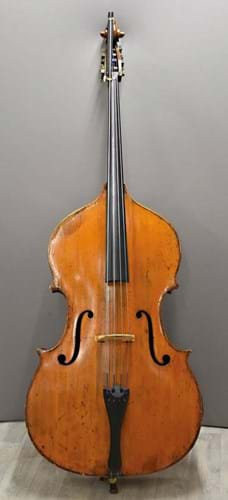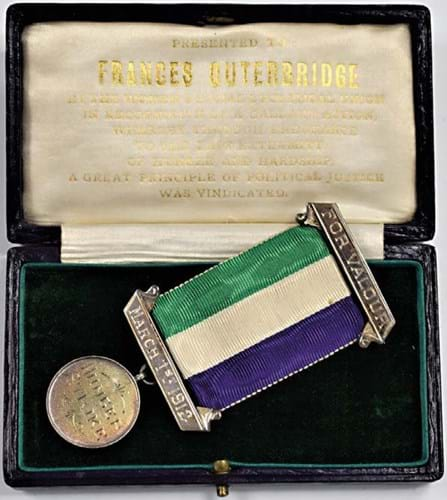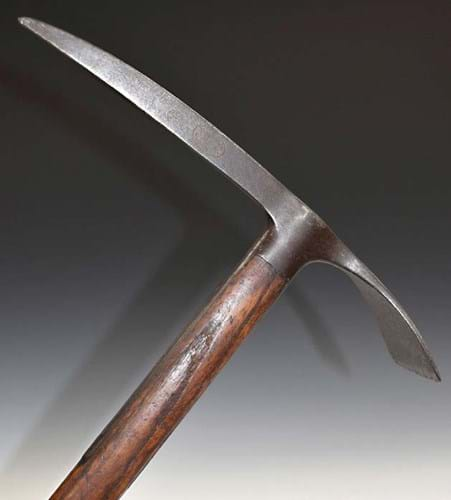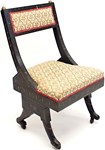An ancient Egyptian greywacke or green siltstone head of a king last sold at Christie’s in 1978 resurfaced in Gloucestershire on January 12.
Estimated at £1500-2000, it did rather better, selling at £32,000 to the UK trade at Stroud Auctions (18% buyer’s premium).
The 10in (24cm) head was undated but the subject wears the nemes headcloth with a chiselled cavity at the brow where a uraeus (cobra symbol of the goddess Wadjet) had once been attached.
He has some of the facial characteristics of the 13th Dynasty king Mentuhotep VI (1675-1650BC).
As evidenced by an original catalogue included with the lot, it had been bought for £1300 (then around £6500) at the antiquities sale in London. It was reoffered here almost 44 years later by a relative at what was a relatively modest sum.
Dodd double bass
This greywacke was one of a number of high-fliers at the 1346-lot sale where 95% got away to a hammer total of £287,000.
Leading the day was a double bass from the Thomas Dodd school.
Dodd (1764-1834) was himself a competent London maker but the reputation of his Covent Garden shop was largely down to the talents of two employees, John F Lott (1776- 1853) and Bernhard Simon Fendt (1769-1832).
Dated c.1820, and originally with the standard three strings of the time, the figured maple and spruce instrument was finished in Dodd’s trademark red-golden brown oil varnish. It was estimated at £15,000-25,000. Commissions ensured the bass would sell well but, on the day, bidding quickly exceeded all hopes, coming down to two UK phone rivals.
The palpable buzz in the room and a ripple of applause when the bass sold at £66,000 is why Stroud Auctions is encouraging bidders to attend in person at a time when others are looking at the bottomline merits of continuing with only remote selling.
Further musical high notes included a silver-mounted double bass bow by the highly regarded Percival Wilfred Bryant (1902-94) and a rock legend Fender guitar,
The bow, featuring an ebony frog with ‘Paris’ eyes and silver button, more than doubled top hopes in going to the trade at £3400.
The 1969 Stratocaster hardtail guitar in lacquered sunburst finish went to the specialist trade at £5700 against a £1000-2000 estimate.
Suffragette reminders
High bids in rarefied areas continued with Suffragette mementoes.
A hallmarked silver hunger strike medal was engraved with the name, date and the gilt encomium Presented to Frances Outerbridge by the Women’s Social & Political Union in recognition of a gallant action, whereby through endurance to the last extremity of hunger and hardship, a great principle of political justice was vindicated.
Outerbridge’s name does not appear in the Suffragette list of recipients of the medal, unlike her lifelong friend, fellow nurse and East End housemate, Caroline Downing.
But on March 1, 1912, at the Bow Street Sessions, when Downing was sent to the infamous force-feeding Winson Green Prison for a windowsmashing protest, so was one Frances Williams.
Williams was the maiden name of Outerbridge’s mother. It seems likely that she gave the false name to avoid embarrassing her uncle, a prominent politician in Bermuda who was pushing for female suffrage on the island (the measure finally passed in 1946).
It was a proud descendant of Frances Outerbridge who consigned the medal, which was estimated at £2000-5000 and sold online to a UK collector at £13,400.
A second lot from the same vendor was more evidence of the friends’ public spirit: a silver-plated tray inscribed Presented to Miss Downing and Miss Outerbridge by the Congregation and Parishioners of St Mark’s, Victoria Park … in appreciation of their self-sacrificing labours among the sick and poor of the parish for ten years, March 1898.
It went to another UK collector, doubling the top estimate at £400.
Everest expedition
Catering to another niche interest were two ice axes used by British mountaineer Theodore Howard Somervell on the Everest expedition he led in 1924.
With impressed marks Gebr Willisch, Tasch-Zermatt, Schweiz, the axes, about 2ft 10in (88cm) and 2ft 9in (84cm) long, were the same model the legendary George Mallory used on his ill-fated 1922 Everest expedition. It was later found on the mountain and at Christie’s in 2014 sold for $240,000 (then about £145,000).
As Somervell neither conquered Everest nor was killed trying (he died aged 85 in 1975), his axes were not expected to approach those heights and at an earlier sale had failed to match a five-figure estimate.
This time each went within revised hopes to the same collector at £3200.
On a day when specialist rarities took the spotlight, there was a more familiar sight in UK salerooms of Chinese porcelain going home. A pair of 6in (15cm) diameter iron red and blue dishes decorated with bats and bearing six-character Guangxu marks estimated at £2000-5000 sold to a bidder from China at £6500.


















